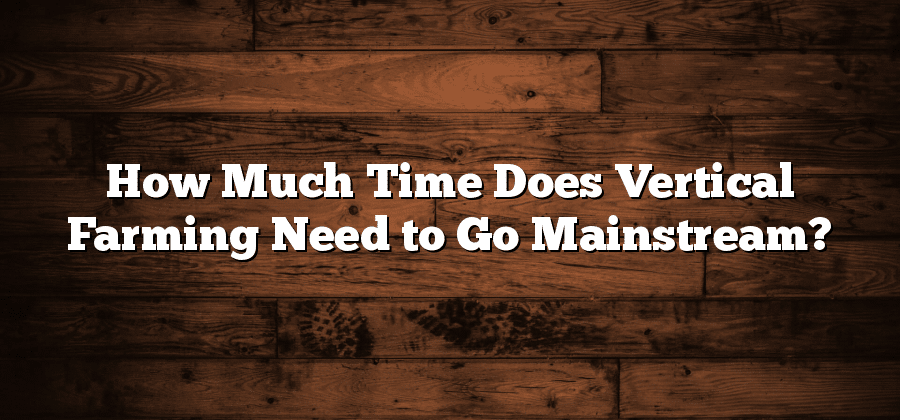The Evolution of Vertical Farming
Vertical farming has come a long way since its inception. Originally conceptualized as a means to address the challenges of limited agricultural space in urban areas, vertical farming has evolved into a sophisticated and promising solution for food production. Its roots can be traced back to the early 20th century, when scientist and inventor, William Frederick Gericke, experimented with hydroponics – the practice of growing plants without soil. However, it wasn’t until the 1990s that the concept of vertical farming gained momentum, with the publication of Dr. Dickson Despommier’s influential book, “The Vertical Farm: Feeding the World in the 21st Century”.
Over the years, vertical farming has undergone significant advancements, driven by the pressing need to ensure food security in a rapidly urbanizing world. The integration of innovative technologies, such as LED lighting, robotics, and climate control systems, has revolutionized the industry, making it increasingly efficient and sustainable. Additionally, the development of advanced cultivation methods, like aeroponics and aquaponics, has further enhanced the potential of vertical farms to maximize yields while minimizing resource consumption. The evolution of vertical farming has not only brought about a paradigm shift in agriculture but also provided a glimpse into the future of sustainable food production.
The Current State of Vertical Farming
Vertical farming has grown significantly in recent years, with numerous high-tech facilities cropping up around the world. The technology has allowed for the cultivation of crops in vertically stacked layers, often in urban settings where traditional farming would not be feasible. This has led to increased access to fresh produce in urban areas and reduced reliance on long-distance transportation.
One of the key advantages of vertical farming is its ability to maximize land utilization. By growing crops in vertical structures, farmers can produce significantly more food per unit of land compared to traditional farming methods. This is particularly important in urban areas where land is scarce and expensive. In addition, vertical farming is not affected by seasonal changes, making it possible to grow crops year-round, resulting in a more consistent supply of fresh produce regardless of the time of year.
Advantages of Vertical Farming
Vertical farming offers numerous advantages over traditional agriculture. Firstly, it allows for year-round cultivation, regardless of external weather conditions. By controlling the indoor environment, vertical farms can grow crops consistently and steadily, without being dependent on seasonal changes or geographical limitations. This presents a significant advantage in regions with extreme climates or limited arable land.
Additionally, vertical farming maximizes land use efficiency. With the increasing global population and urbanization, land scarcity is a pressing issue. Vertical farms provide a solution by using multi-level cultivation systems that stack layers of crops vertically, thereby maximizing the use of available space. This vertical arrangement enables higher crop yields per square meter, reducing the need for expansive land areas and preserving natural habitats. Moreover, vertical farming minimizes water usage by implementing advanced irrigation systems and reusing water, making it a sustainable choice for a water-scarce future.
Challenges Hindering Mainstream Adoption
Vertical farming holds immense potential to revolutionize the way we produce food. However, several challenges hamper its widespread adoption and mainstream implementation. One of the primary challenges is the high initial investment required to set up a vertical farm. The cost involved in constructing the infrastructure, installing specialized lighting and irrigation systems, as well as implementing climate control technologies can be prohibitively expensive for many farmers or investors.
Additionally, the operational costs of vertical farming are often higher compared to traditional farming methods. The energy consumption for providing artificial lighting, maintaining optimal climate conditions, and running automated systems can significantly impact the financial viability of vertical farms. These higher operational costs become a limiting factor in the profitability and scalability of vertical farming ventures. Moreover, the need for qualified personnel with expertise in vertical farming techniques further adds to the financial burden, as skilled labor can be scarce and expensive to hire. Overall, the high upfront and operational costs pose a significant challenge that hinders the mainstream adoption of vertical farming.
Technological Innovations Driving Progress
One of the key drivers behind the progress in vertical farming is the continuous advancements in technology. The integration of cutting-edge innovations has significantly improved the efficiency and sustainability of indoor agricultural practices. For example, the emergence of smart sensors and automation systems has revolutionized the way crops are monitored and controlled in vertical farms.
These technological advancements enable real-time data collection, allowing farmers to closely monitor plant health, temperature, humidity, and nutrient levels. This precise monitoring helps optimize growing conditions to ensure maximum crop yield and quality. Additionally, automated systems can adjust lighting, irrigation, and ventilation to create the ideal environment for different crops, leading to improved resource efficiency and reduced waste. Such technological innovations are not only enhancing the productivity of vertical farms but also increasing their economic viability and potential for scalability.






